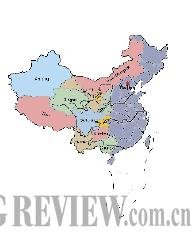|
West China also accounts for 27.5 percent of the country's population, but its consumption accounts for only 18.4 percent of the national total, making it a potential hotspot for consumer growth.
Mounting support
The NDRC plans to provide 682 billion yuan ($100 billion) as financial support for the western region over the next few years, and it will also enact favorable policies to lure private investment and bank lending to the region, said Du.
The Central Government has leaned toward the western region in fiscal allocation and investments. Over the past decade, the central finance's transfer payment to the western region exceeded 4 trillion yuan ($588 billion), and the state budgetary investment in the region's capital infrastructure construction added up to 890 billion yuan ($131 billion). During the 12th Five-Year Plan period (2011-15), the support will increase by 20 percent annually, said Du.
But the government efforts are only a small part of investments in the western region. Central Government investments in the region amounted to barely 900 billion yuan ($132 billion) in the past decade, compared with nearly 20 trillion yuan ($3 trillion) of fixed-asset investments in the region during this period.
Remarkable achievements
Since China started the western development program in 2001, west China has reaped great economic benefits. "The region maintained an annual economic growth of 11.9 percent and more than doubled its major economic indicators in the past 10 years," said Du.
NDRC data showed the region's GDP soared from 1.6655 trillion yuan ($245 billion) in 2000 to 6.6868 trillion yuan ($983 billion) in 2009, with the local fiscal revenues jumping from 112.7 billion yuan ($17 billion) to 605.5 billion yuan ($89 billion). Besides this, retail sales of consumer goods leapt from 599.7 billion yuan ($88 billion) to 2.3039 trillion yuan ($339 billion), and the region's foreign trade volume grew from $17.2 billion to $91.5 billion.
In addition, the western region made breakthroughs in its infrastructure construction over the past decade, including the Qinghai-Tibet Railway and the west-to-east natural gas and electricity transmission projects, Du said. The length of railways and highways open to traffic in the region is now 1.5 times and 2.8 times that of 10 years ago, respectively.
And in the last decade, fixed-asset investments in west China totaled nearly 20 trillion yuan ($3 trillion), 5.5 times that during the 50 years from 1949 to 1999.
The western region also achieved remarkable accomplishments in ecological improvement. Land reclaimed and replaced with forests in the region totaled 16 million hectares in the past decade, and the area of grazing land restored to grassland reached 45 million hectares. The forest coverage rate increased from 10.32 percent to 17.05 percent in those 10 years.
Besides this, the Central Government has invested at least 100 billion yuan ($15 billion) in more than 50 social welfare projects in the region, significantly improving local education, sanitation, culture, sports, social security and employment, said Du.
The local people's living standards have also improved. The per-capita income of urban and rural residents is now 2.7 times and 2.3 times greater, respectively, than 10 years ago. The region's poor population currently stands at around 23.7 million, down from 57 million a decade ago.
"The enormous changes in the western region over the past decade have made phenomenal contributions to the country's overall development," said Du. "The western economy is picking up steam, and residents in the region now live better lives." n
Three Steps

Phase 1 (2001-10): Adjust the economic structure; lay a solid foundation for infrastructure, ecological environment and science and technology education; improve the investment environment; curb environment degradation; and lift the economic growth rate in the region to the national average.
Phase 2 (2010-30): Continue with economic improvements; foster pillar industries; improve the modern market economy; and pave the way for the regional economy to take off.
Phase 3 (2031-50): Enhance the economic strength in relatively prosperous areas; integrate the western region into modernized domestic and international economic systems; accelerate development in remote rural areas; and enhance the production and living levels of local residents.
| 